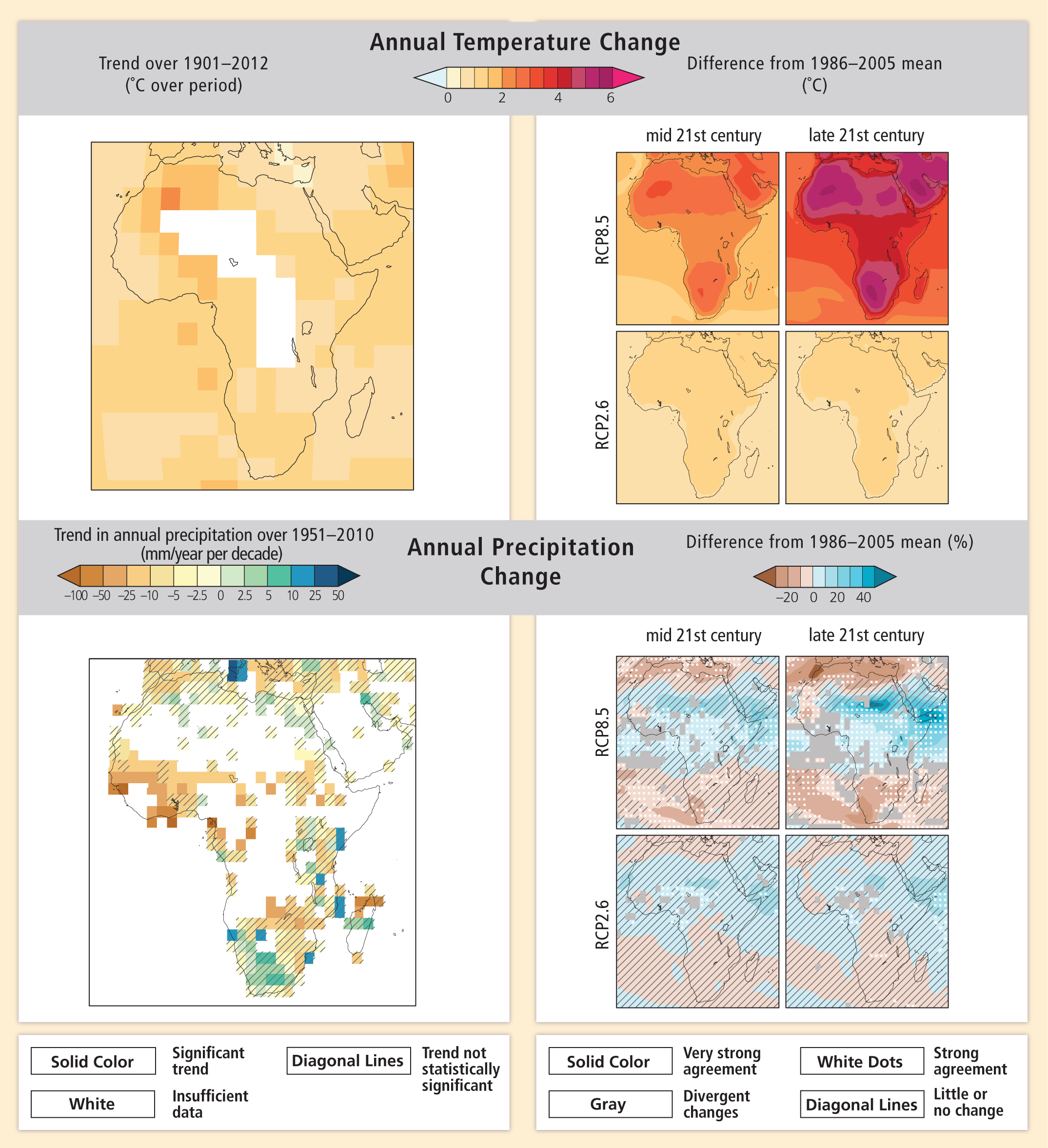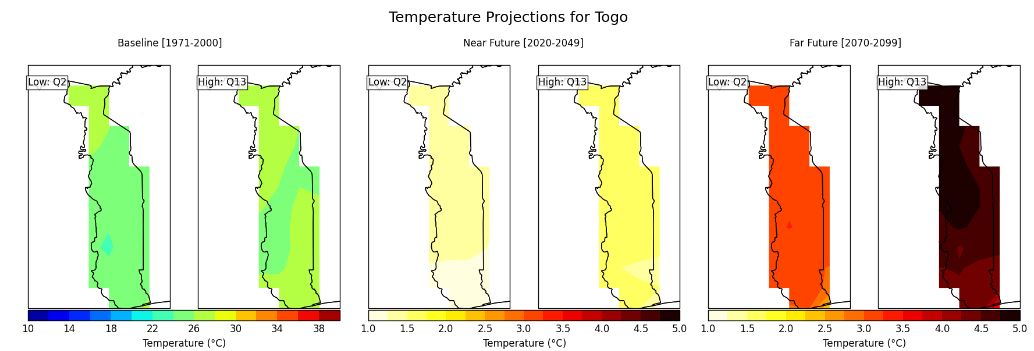Key findings: There is a high level of confidence that temperatures will increase in the West Africa region. By contrast, there is little consensus on the direction and magnitude of potential changes in rainfall. Climate change is likely to lead to an increase in carbon storage in forests and an increase in vegetation productivity in most of West Africa, but this increase could be limited by land use change. Ecosystems are also projected to shift northwards in central and eastern West Africa.
The Met Office Hadley Centre (MOHC) provided high resolution climate projections for the project. They also studied the potential future impact of land use change and climate change on ecosystem services in the region, and provided a summary of their projections for each core project country.
HIGH RESOLUTION CLIMATE DATA
The MOHC used an ensemble of Regional Climate Model (RCM) simulations to provide high resolution baseline and future climate projections for the project. The model simulations were run from December 1949 to December 2099 using the MOHC regional climate modelling system, PRECIS, to generate a range of future climate scenarios under the IPCC Special Report on Emissions Scenarios (SRES) medium high A1B emissions scenario, over the 50km resolution Africa CORDEX (CO-ordinated Regional Downscaling Experiment, http://www.cordex.org/) domain. These simulations generated a comprehensive dataset of surface and atmospheric climate variables including minimum and maximum temperatures and precipitation at the daily and monthly timescale. The experimental design used is detailed in the technical report.
REGIONAL CLIMATE PROJECTIONS
Climate projections were derived from global and regional climate model experiments to assist in informing country-level decision making and adaptation activities in the five project countries. The climate of West Africa has been observed to be changing in recent decades, with some of these changes clearly attributable to global climate change. Projections of future regional climate change are increasingly being used as a tool to inform adaptation, policy and decision making activities, and it is necessary that these be combined with local decision making and adaptation strategies.
Here, five high resolution regional climate simulations were performed to assess the potential changes in temperature and rainfall across West Africa at a spatial scale relevant to assessing impacts of these changes. These regional experiments all suggest a general warming trend, in agreement with wider global climate experiments used to inform the Intergovernmental Panel on Climate Change Fifth Assessment Report (IPCC AR5). In conjunction with this warming, an increase in year-to-year variability is also apparent within the regional climate results, and could result in a greater frequency of unusually hot events. The high level of agreement across global and regional climate models for West Africa allows us to say with high confidence that a projected increase in temperature is very likely to occur. This could have large impacts on ecosystems and livelihoods across the West African region, and implies that adaptation of these systems is required in order to make them resilient in the face of any negative consequences.
With regards to rainfall in the five focal countries, the projections of both regional and global climate modelling experiments are highly variable, and often do not provide consensus on the direction, and certainly not the magnitude, of potential changes in rainfall. Within the set of global model results presented in the IPCC AR5, over much of the region, both significant increases and decreases are projected. This is also the case for the regional climate model projections in parts of the five project countries, though in other parts there is a general consensus on either increases or decreases in rainfall. However, given the widespread of results within the IPCC context, these results may not fully encapsulate the range of possible outcomes. Thus, the best advice currently is to build robust resilience to current precipitation variability, as either the drier or wetter events, or both, could be enhanced in the future.

Observed and projected changes in annual average temperature and precipitation. Left panels: Observed annual average temperature change from 1901-2012 (top) and observed annual precipitation change from 1951-2010 (bottom) derived from a linear trend. For observed temperature and precipitation, white areas depict regions which lack sufficient observational data for analysis. Solid colours indicate areas where trends are significant at the 10% level. Diagonal lines indicate areas where trends are not significant. Right panels: CMIP5 multi-model mean projections of annual average temperature changes (top) and average percent changes in annual mean precipitation (bottom) for two time periods (2046-2065 and 2081-2100) under two RCP emissions scenarios. Solid colours indicate very strong agreement amongst models, white dots represent strong agreement, grey areas depict divergent changes, and diagonal lines represent areas with little or no change with respect to current climate variability.
PROJECTIONS OF CHANGE IN ECOSYSTEM SERVICES
The MOHC subsequently analysed the combined and separate future impact of land use change and climate change on ecosystem services and other benefits provided by ecosystems in West Africa, including carbon storage, water provision and vegetation productivity. The ensemble of regional climate projections developed for the project were used to run a model that simulates exchanges of carbon, energy and moisture between the land surface and the atmosphere, using three different scenarios of future land use change. These scenarios account for different levels of human disturbance of the land surface, and different levels of protection of primary forests.
Confidence in the results from this study is directly related to confidence in the climate projections for both temperature and precipitation. Therefore, we have identified results as either (a) results we have confidence in because we have high agreement between the models and a physical understanding of why the change has been projected, or (b) results which are plausible because we cannot exclude them as being wrong, but that we have low confidence in because results from other models are different but also plausible.
The main findings for the region are:
● Carbon storage of forests is projected to increase under the effects of climate change, however, forest degradation would restrict this increase (confident).
● Generally, vegetation productivity is projected to increase in most parts of West Africa. The exceptions to this are in southern Nigeria, where land use scenarios estimate a high level of human activity, and in the western Sahel, where a drying signal is found in the climate projections (plausible).
● In central and eastern West Africa, ecosystems are projected to shift northwards. This includes an increase in tree fraction of ecosystems in Cameroon and Central African Republic (confident), increases in shrub fraction in the savannah grasslands of southern Chad and northern Nigeria (confident), and increases in grass fraction on the edge of the Sahara desert in Chad and Niger (plausible).
Key findings for the ecosystem services of each the five project countries are summarized in the report.
COUNTRY FACTSHEETS
For each country (in alphabetical order below), the MOHC provided a summary of the climate projections, their likely impacts on ecosystem services, and advice for national planning. Here we only highlight the findings with regards to ecosystem services and planning recommendations.
Chad
Chad is projected to experience a northward shift of ecosystems. This includes increases in shrub and tree cover in southern woody savannah ecosystems, and increases in grassland vegetation cover in arid and semi-arid ecosystems of central Chad on the edge of the Sahara. Projected increases in surface run off suggest more water available for ecosystems and agriculture, although this is strongly related to precipitation projections that are plausible but not confident. Increases in vegetation productivity in central and southern Chad are also projected, indicating potentially larger crop yields, however, again these projections are related to precipitation change and are seen as plausible but not confident. In the subtropical south of Chad, increases in vegetation productivity are more closely related to increases in mean annual temperature, indicating a higher confidence. Projections for precipitation are much less certain, especially in the Sahel region of Chad, an area where vegetation productivity is strongly dependent on precipitation. Therefore, projected increases in precipitation in this region are plausible but not confident, and as the region is subject to significant rainfall variability, drought seasons should still be planned for.


Temperature (annually averaged surface temperature (˚C)) (top) and precipitation (seasonal total rainfall (mm) in the JAS season) (bottom) projections for Chad, for the baseline period (1971-2000), and projected changes for the near future (2020-2049) and far future (2070-2099), for the RCM models with the lowest and highest projected sensitivities in the far future time period.
Gambia
Projections for ecosystem services suggest that an increase in the bare soil fraction, replacing grass cover, as well as a small reduction in vegetation productivity might occur. However, these are related to a projected decrease in western Sahelian precipitation and are thus plausible but not confident projections. Projections for change in grass and bare soil fractions in Gambia are also highly sensitive to precipitation variability, indicated by both year-to-year variability and decade-to-decade variability in vegetation cover. Planning should therefore account for the possibility that total monsoon precipitation might decrease in the far future. However, given the lack of robust evidence to support this projection, it would be prudent to plan for climate variability and extremes, as these have been observed in the last three decades. National planners should be aware that temperature increases above the national average (up to 5.5°C in the far future) are projected with high confidence for the east of Gambia.


Temperature (annually averaged surface temperature (˚C)) (top) and precipitation (seasonal total rainfall (mm) in the JAS season) (bottom) projections for the Gambia, for the baseline period (1971-2000), and projected changes for the near future (2020-2049) and far future (2070-2099), for the RCM models with the lowest and highest projected sensitivities in the far future time period.
Mali
In the south of Mali, projections are for an increase in the bare soil fraction, replacing grass cover, and a reduction in vegetation productivity in arid and semi-arid parts of the country, however, these are related to a projection of decreased western Sahelian precipitation and so are plausible, but not confident projections. Grass and bare soil fractions in southern Mali are highly sensitive to precipitation variability, indicated by both year-to-year variability and decade-to-decade variability in vegetation cover. While the strong drying signal in the south of Mali is highly uncertain, this is a plausible projection and should be considered as a possibility when planning for the future. When developing climate change adaptation plans, it is essential to build in resilience to wet years, as well as dry years, in order to account for extremes of year-to-year and decade-to-decade variability, as observed in the past. The projections indicate that there is high confidence that this kind of variability will continue into the far future.


Temperature (annually averaged surface temperature (˚C)) (top) and precipitation (seasonal total rainfall (mm) in the JAS season) (bottom) projections for Mali, for the baseline period (1971-2000), and projected changes for the near future (2020-2049) and far future (2070-2099), for the RCM models with the lowest and highest projected sensitivities in the far future time period.
Sierra Leone
Increases in the fraction of broadleaf tree cover are projected to occur with high confidence throughout Sierra Leone, although human disturbance would restrict this increase. Vegetation productivity is also projected to increase as broadleaf tree cover increases. This is related to increases in minimum temperature, since photosynthesis is not limited by water availability in this region, and this is therefore a confident projection. There is a large variability in the projections of change in surface runoff with increases towards the end of the century related to precipitation change and thus these projections are plausible but not confident. The results indicate that tropical forests in Sierra Leone will become an even more valuable resource for storing carbon in the future, therefore contributing to mitigation of global climate change. However, including scenarios of future land use shows that human disturbance would significantly reduce this potential and so minimising this would maximise the mitigation potential of the projected increase in forest carbon storage.


Temperature (annually averaged surface temperature (˚C)) (top) and precipitation (seasonal total rainfall (mm) in the JAS season) (bottom) projections for Sierra Leone, for the baseline period (1971-2000), and projected changes for the near future (2020-2049) and far future (2070-2099), for the RCM models with the lowest and highest projected sensitivities in the far future time period.
Togo
Under a scenario of no human disturbance to natural vegetation, small increases in vegetation productivity are projected in Togo, resulting in an increase in vegetation carbon in woody savannah ecosystems, and are related to temperature change and thus confident projections. Including human disturbance, however, leads to a reduction in vegetation carbon in central Togo with high confidence. A small increase in the fraction of broadleaf tree cover over most of Togo is projected in some, but not all, regional climate model projections so should be considered plausible but not confident. In the south of Togo, these results show with high confidence that by limiting future land use change, increases in the carbon storage of forest and savannah ecosystems can be achieved. Future increases in woody savannah in the WAP ('W', Arly, Pendjari) complex, which is a plausible, but not confident projection, may present challenges for the management of biodiversity and the annual fire regime.


Temperature (annually averaged surface temperature (˚C)) (top) and precipitation (seasonal total rainfall (mm) in the JAS season) (bottom) projections for Togo, for the baseline period (1971-2000), and projected changes for the near future (2020-2049) and far future (2070-2099), for the RCM models with the lowest and highest projected sensitivities in the far future time period.











